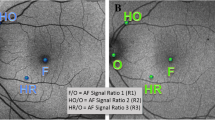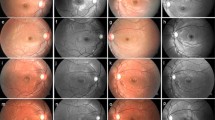Abstract
Background
Fundus autofluorescence (AF) in some patients with retinitis pigmentosa is characterized by a parafoveal ring of increased AF which surrounds the centre as hypofluorescent changes appear at the periphery. The aim of this study was to evaluate the AF patterns in relation to retinal function measured by electroretinography and visual fields.
Methods
Thirty-two patients with RP were included in the study. AF imaging of the macular area was performed with the scanning laser ophthalmoscope. Patients were divided in two groups according to their fundus AF patterns. All patients from group 1 had a ring of increased AF of different size but no atrophic areas inside vascular arcades. Patients with a ring of increased AF and round atrophic changes at different eccentricities from their fovea were selected in group 2. Visual fields were tested with kinetic, automated perimetry and microperimetry; the radius of the hyperfluorescent ring and the smallest distance of hypofluorescent areas from the fovea were compared to visual fields, PERG P50 and N95 and mfERG P1 amplitudes of the inner three rings.
Results
A linear relationship was found in group 1 between the radius of the ring of increased AF and both the automated (r=0.82) and kinetic perimetry (r=0.80). The radius of the AF ring correlated highly with the PERG P50 (r=0.72) and N95 (r=0.74) amplitudes. In all patients, mfERG responses were reduced at all retinal locations, more pronounced at periphery. There was a good correlation between the ring of increased AF and the P1 amplitude of ring 2 of mfERG (r=0.62). Patients from group 2 had significantly reduced or non-recordable PERGs and mfERGs. The eccentricities of hypofluorescent changes did not correlate with any type of perimetry.
Conclusions
Our results show that in stages of retinitis pigmentosa, before atrophic lesions spread inside the vascular arcades, the pattern of fundus autofluorescence correlates well with functional tests such as perimetry and electroretinography. The ring of increased AF appears to represent the border between functional and dysfunctional retina. This shows that autofluorescence, as a quick and non-invasive imaging tool, may be related to retinal function as well.







Similar content being viewed by others
References
Adler R (1996) Mechanisms of photoreceptor death in retinal degenerations. Arch Ophthalmol 114:79–83
Bach M, Hawlina M, Holder GE, Marmor MF, Meigen T, Vaegan, Miyake Y (2000) Standard for pattern electroretinography. Doc Ophthalmol 99:11–18
Besch D, Zrenner E (2003) Prevention and therapy in hereditary retinal degenerations. Doc Ophthalmol 106:31–35
Delori FC, Dorey CK, Staurenghi G et al. (1995) In vivo fluorescence of the ocular fundus exhibits retinal pigment epithelium lipofuscin characteristics. Invest Ophthalmol Vis Sci 36:718–729
Delori FC, Staurenghi G, Arend O, Dorey CK et al. (1995) In vivo measurement of lipofuscin in Stargardt’s disease- fundus flavimaculatus. Invest Ophthalmol Vis Sci 36:2327–2331
Delori FC, Goger DG, Dorey CK (2001) Age-related accumulation and spatial distribution of lipofuscin in RPE in normal subjects. Invest Ophthalmol Vis Sci 42:1855–1866
Dorey CK, Wu G, Ebenstein D, Garsd A, Weiter JJ (1989) Cell loss in the aging retina. Relationship to lipofuscin accumulation and macular degeneration. Invest Ophthalmol Vis Sci 30:1691–1699
Hawlina M, Konec B (1992) New noncorneal HK-loop electrode for clinical electroretinography. Doc Ophthalmol 81:253–259
Hawlina M, Jarc M, Popovic P (1998) Pattern ERG is preserved in retinitis pigmentosa—a follow up study. Electroncephalogr Clin Neurophysiol 106:46
Holder GE (2001) Pattern electroretinography (PERG) and an integrated approach to visual pathway diagnosis. Prog Retin Eye Res 20:531–561
Holder GE, Robson AG, Hogg CR, Kurz-Levin M, Lois N, Bird AC (2003) Pattern ERG: clinical overview, and some observations on associated fundus autofluorescence imaging in inherited maculopathy. Doc Ophthalmol 106:17–23
Holz FG (2001) Autofluorescenz-imaging der Makula. Ophthalmologe: 98:10–18
Hood DC (2000) Assessing retinal function with the multifocal technique. Prog Ret Eye Res 19:607–646
Hood DC, Frishman LJ, Saszik S, Viswanathan S (2002) Retinal origins of the primate multifocal ERG: Implications for the human response. Invest Ophthalmol Vis Sci 43:1673–1685
Kennedy CJ, Rakoczy PE, Constable IJ (1995) Lipofuscin of the retinal pigment epithelium: a review. Eye 9:763–771
Lorenz B, Wabbels B, Wegscheider E, Hamel CP, Drexler W, Preising MN (2004) Lack of fundus autofluorescence to 488 nanometers from childhood on in patients with early-onset severe retinal dystrophy associated with mutations in RPE65. Ophthalmology 111:1585–1594
Marmor MF, Hood DC, Keating D, Kondo M, Seeliger MW, Miyake Y (2003) Guidelines for basic multifocal electroretinography (mfERG). Doc Ophthalmol 106:105–115
Popović P, Jarc-Vidmar M, Brecelj J, Hawlina M (2002) Pattern electroretinography in relation to perimetry and visual acuity in patients with retinitis pigmentosa. Zdrav Vestn 71:119–124
Rohrschneider K, Bültmann S, Kiel R, Weimar P, Krastel H, Blankenagel A (2002) Diagnostik bei Netzhauterkrankungen. Vergleich von multifokalem ERG und funduskontrollierter Perimetrie—Fallstudie. Ophthalmologe 99:695–702
Robson AG, El-Amir A, Bailey C, Egan CA, Fitzke FW, Webster AR, Bird AC, Holder GE (2003) Pattern ERG correlates of abnormal fundus autofluorescence in patients with retinitis pigmentosa and normal visual acuity. Invest Ophthalmol Vis Sci 44:3544–3550
Robson AG, Egan CA, Luong VA, Bird AC, Holder GE, Fitzke FW (2004) Comparison of fundus autofluorescence with photopic and scotopic fine-matrix mapping in patients with retinitis pigmentosa and normal visual acuity. Invest Ophthalmol Vis Sci 45:4119–4125
Robson AG, Egan CA, Bird AC, Fitzke FW, Holder GE (2003) Multi-focal ERG, pattern ERG and psychophysical correlates of fundus autofluorescence abnormalities in patients with retinitis pigmentosa. Invest Ophthalmol Vis Sci 44:E-Abstract 535
Ross DF, Fishmann GA, Gilbert LD (1984) Variability of visual field measurements in normal subjects and patients with retinitis pigmentosa. Arch Ophthalomol 102:1004–1010
von Rückmann A, Fitzke FW, Bird AC (1995) Distribution of fundus autofluorescence with scanning laser ophthalmoscope. Br J Ophthalmol 79:407–412
von Rückmann A, Fitzke FW, Bird AC (1997) In vivo fundus autofluorescence in macular dystrophies. Arch Ophthalmol 115:609–615
von Rückmann A, Fitzke FW, Bird AC (1999) Distribution of pigment epithelium autofluorescence in retinal disease state recorded in vivo and its change over time. Graefe’s Arch Clin Exp Ophthalmol 237:1–9
Scholl HP, Chong NH, Robson AG, Holder GE, Moore AT, Bird AC (2004) Fundus autofluorescence in patients with Leber congenital amaurosis. Invest Ophthalmol Vis Sci 45:2747–2752
Wegscheider E, Preising MN, Lorenz B (2004) Fundus autofluorescence in carriers of X-linked recessive retinitis pigmentosa associated with mutations in RPGR, and correlation with electrophysiological and psychophysical data. Graefe’s Arch Clin Exp Ophthalmol 242:501–511
Wong F (1995) Photoreceptor apoptosis in animal models. Implications for retinitis pigmentosa research. Arch Ophthalmol 113:1245–1247
Acknowledgements
This study was supported by the grant of Ministry of Education, Science and Sports of Republic of Slovenia No. J3-4393. and was in part presented at 2004 ARVO meeting, Fort Lauderdale, USA. Authors are grateful to Dr. Jelka Brecelj for valuable comments and advice and to Barbara Klemenc for technical support.
Author information
Authors and Affiliations
Corresponding author
Rights and permissions
About this article
Cite this article
Popović, P., Jarc-Vidmar, M. & Hawlina, M. Abnormal fundus autofluorescence in relation to retinal function in patients with retinitis pigmentosa. Graefe's Arch Clin Exp Ophthalmo 243, 1018–1027 (2005). https://doi.org/10.1007/s00417-005-1186-x
Received:
Revised:
Accepted:
Published:
Issue Date:
DOI: https://doi.org/10.1007/s00417-005-1186-x




